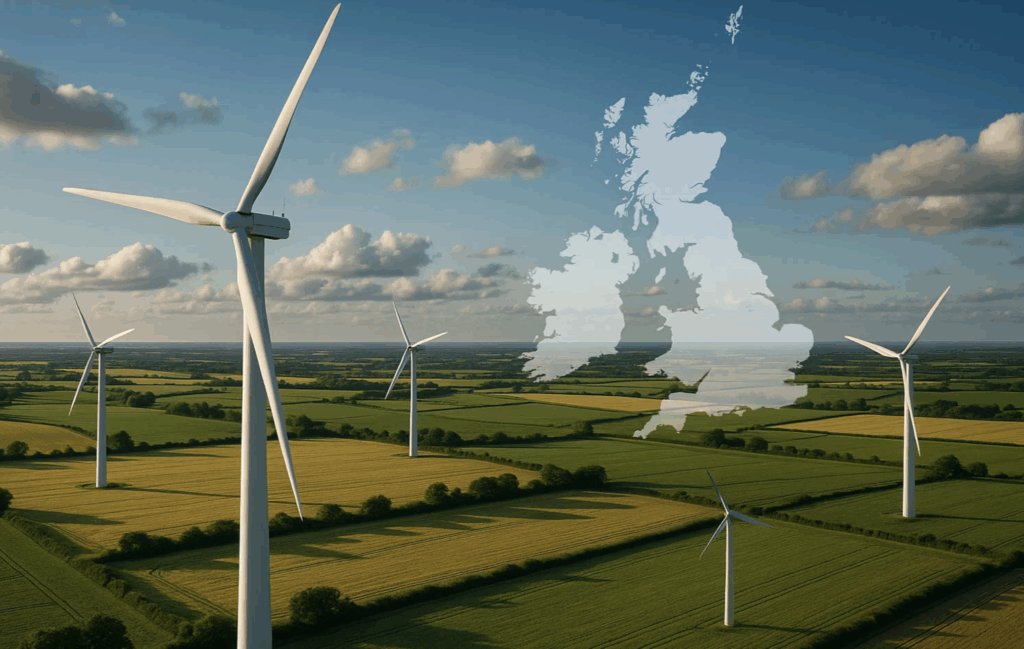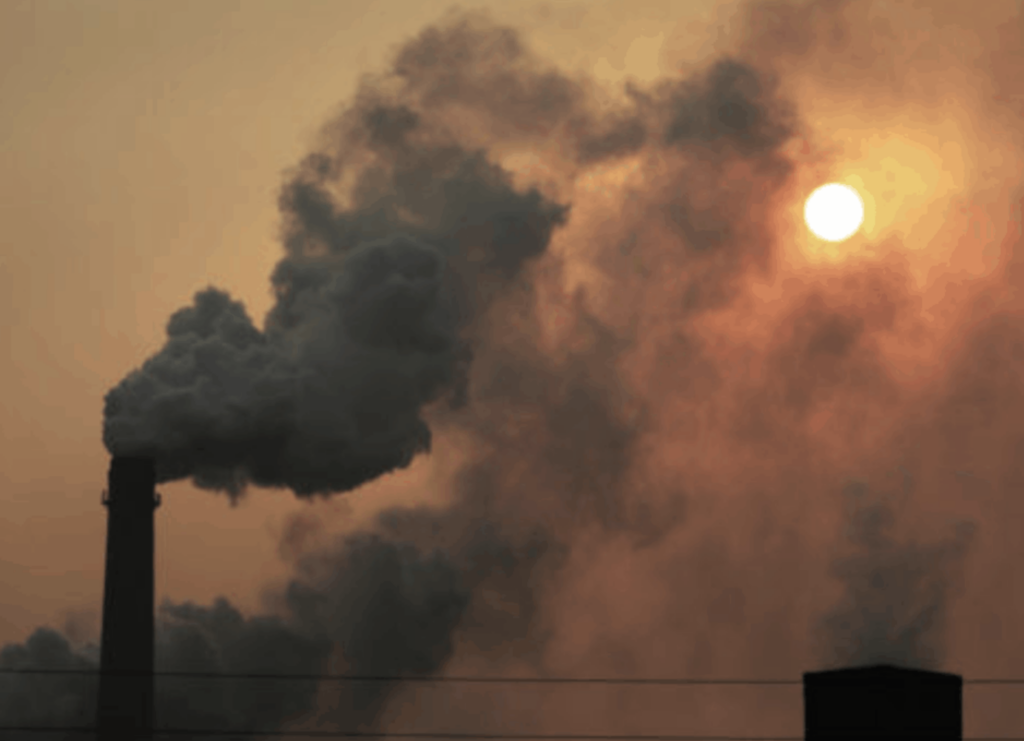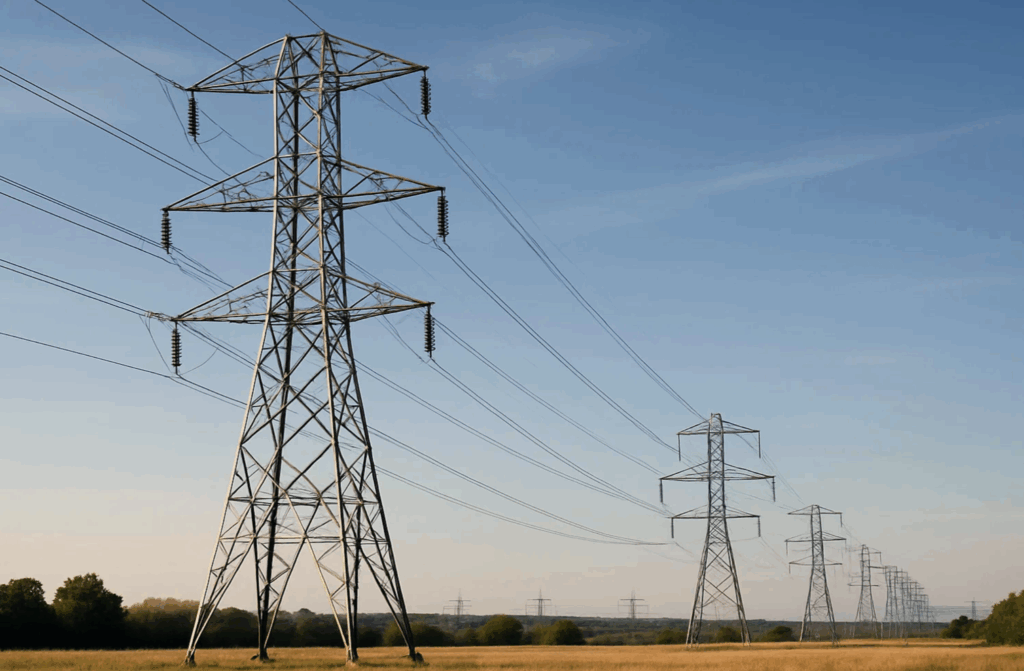The UK’s national grid is undergoing a historic transformation to cut carbon emissions and deliver cleaner electricity. Over the past decade, Britain has rapidly moved away from coal and other fossil fuels towards renewable energy sources, such as wind and solar.
The ongoing decarbonisation of the grid means that every unit of electricity now generates far less carbon dioxide than it once did. A greener grid is steadily taking shape, transforming not only how the nation produces its power but also how we use it in our daily lives. One clear example is in home heating: electric fires are becoming an increasingly sustainable option, as the electricity that powers them continues to grow cleaner year by year.

The UK’s Journey to a Low-Carbon Grid
Britain’s power grid was once dominated by coal. As recently as 2013, coal-fired power plants generated around 40% of UK electricity. Today, there are no longer any coal-fired power stations left in the UK. The last one was Ratcliffe-on-Soar, which closed in September 2024. Several key milestones mark the road to a cleaner grid:
2015: Coal Phase-Out Announced: In November 2015, the UK Government announced a plan to close all remaining coal-fired power stations by 2025. This commitment set the scene for an accelerated shift to low-carbon power.
2016: First Coal-Free Hours: In May 2016, for the first time since the 19th century, Britain’s grid operated for short periods with no coal-fired generation at all. That same year, three major coal plants were closed as cleaner gas and renewables filled the gap.
2017: A Day Without Coal: On 21 April 2017, Britain logged its first full 24 hours without coal-fired electricity since the Industrial Revolution. This key moment highlighted how quickly the energy mix was changing. By this time, renewable output had grown substantially, and the country co-founded the international Powering Past Coal Alliance to encourage others to abandon coal. The Powering Past Coal Alliance (PPCA) is a coalition of national and subnational governments, businesses and organisations working to advance the transition from unabated coal power generation to clean energy.
2019: Renewables Overtake Fossil Fuels: In 2019, for the first time ever, the UK’s zero-carbon electricity (from renewables and nuclear) outpaced its fossil fuel generation over the year. In August of that year, wind, solar, nuclear, and hydro together reached a record high of 85% of the generation mix at one time. Coal’s role had reduced so much that Britain also recorded its first coal-free week in 2019.
2020: Longest Coal-Free Run: During low demand during COVID-19 lockdowns, spring 2020 saw Britain go 68 days without burning coal for power, the longest stretch in over 130 years. By 2020, coal was supplying only around 2% of electricity annually. That year, 43% of the UK’s electricity came from renewables, the first year on record that renewables dominated the mix.
2024: The End of Coal: The UK reached a landmark in September 2024, when its last operational coal plant, the previously mentioned Ratcliffe-on-Soar, closed for good, achieving the government’s coal phase-out goal a year early. Coal, which had generated the bulk of British electricity for over a century, was virtually eliminated.

These milestones demonstrate a fast decline of coal power. In 2013, coal still made up about 40% of the electricity mix; by 2023, it was virtually 0%. This was matched by a huge growth in renewable energy. Over the decade from 2013 to 2023, wind power surged from providing 8% of Britain’s electricity to roughly 29%. Investment in large offshore wind farms, onshore turbines, solar farms, and bioenergy has expanded the capacity of renewables sixfold since 2008.
The grid has also benefited from improved energy efficiency and changing consumption habits. Nationwide electricity demand in 2023 was actually 17–21% lower than in 2013, thanks to more efficient appliances, LED lighting, and the decline of heavy industry. This reduced demand, combined with more green supply, created a perfect formula for cutting carbon emissions.
How a Greener Grid Produces Electricity with Less Carbon
What does it mean to decarbonise the grid? It means generating power with little to no carbon dioxide emissions. Traditionally, burning coal or gas to make electricity releases CO2 and other pollutants as byproducts. By switching to low-carbon energy sources, the UK now produces each kilowatt-hour of electricity with a fraction of the emissions it used to. In 2013, the carbon intensity of UK electricity was around 450–500 grams of CO2 per kWh; fast forward to 2023, and it averaged only about 149–162 grams CO2 per kWh.
Several technologies and changes make this possible:
Renewable Energy: The backbone of the low-carbon grid is renewables. Wind turbines harness kinetic energy from the atmosphere to spin generators without any fuel or emissions. The UK, with strong winds especially offshore, has built large wind farms in the North Sea and around coastal areas. By 2023, wind alone accounted for nearly a third of UK electricity generation. Solar panels, though a smaller slice due to the climate, convert sunlight into power with zero emissions. Hydropower and biomass also contribute. Every unit of electricity from wind or solar displaces one that would have come from burning fuel, directly cutting CO2 output.
Cleaner Fuels and Efficiency: Even for remaining fossil fuel generation, the UK has moved from high-carbon coal to lower-carbon natural gas. Burning natural gas in efficient combined-cycle turbines emits less than half the CO2 of coal per kWh generated. Modern gas power stations can ramp up and down to balance the variable output of wind and solar.
Furthermore, policies like the carbon price floor (a tax on CO2 emissions) made coal uneconomical, speeding up its phase-out. The grid is also cleaner thanks to nuclear power, which has long provided around 15–20% of electricity with minimal carbon emissions. Nuclear plants don’t emit CO₂ during operation. While some older reactors are retiring, the UK plans to build new nuclear capacity to complement renewables as a steady, low-carbon source.
Grid Management and Innovation: Operating a grid with lots of renewables requires intelligent management. The National Grid has developed new ways to keep providing power without fossil fuels, such as using energy storage, interconnecting with other countries, and demand response (adjusting consumption patterns). Significant investments in energy storage (like large battery installations and pumped hydro storage) help capture excess wind or solar power and release it when needed, reducing reliance on gas peaker plants (power stations that run on natural gas to provide electricity during periods of high demand). Improved forecasting of weather and renewable output allows grid operators to plan ahead and maintain reliability. This is a key stepping stone towards the government’s goal of a completely carbon-free electricity system by 2035.

The scientific insight here is that producing electricity with less carbon isn’t due to one single thing, but a combination of diversifying energy sources and improving technology. A wind turbine or solar panel generates electricity without combustion, tapping energy flows in nature (wind, sunlight, water) and converting them to electricity with no direct emissions. In contrast, older coal plants burned solid carbon fuel, releasing huge CO2 emissions for each unit of power.
By redesigning the generation mix, the UK now gets more energy from processes that emit less carbon. Additionally, even when fossil gas is used, modern engineering, like high-efficiency turbines, extracts more electricity per unit of gas, so less CO2 is emitted for the same power output. Britain’s overall greenhouse gas emissions in 2023 decreased by 5.7%, reaching the lowest level in nearly 150 years.
Despite this progress, challenges still remain. On calm days with low wind, the grid still leans on gas-fired plants to meet demand. Fossil gas remains the single biggest source of electricity and the next target of decarbonisation efforts. Looking ahead, the UK plans a significant expansion of offshore wind, aiming for 50 GW (50 billion watts) of capacity by 2030, as well as substantial growth in solar farms. Together with new nuclear stations and potentially emerging technologies like hydrogen or carbon capture, these will further reduce the carbon footprint of electricity. By around 2035, we can expect that virtually all our power will come from zero-carbon sources, a significant shift from the coal-dependent grid of the past.
A Sustainable Heating Revolution: Electric Fires in a Green Grid
One of the most encouraging outcomes of a cleaner grid is in the area of home heating. Heating and cooling are major energy uses, and historically in the UK, heating has been dominated by natural gas boilers or wood and coal open fires, all of which produce carbon emissions and, in the case of open fires, significant air pollution. Now, as electricity becomes a low-carbon energy carrier, using electricity for heating becomes far more environmentally friendly than it once was.
Electric fires have been around for decades as a secondary heating option, but they haven’t always been seen as eco-friendly due to the past carbon intensity of the grid. That’s changing fast. Electric heating solutions have gained traction due to decarbonisation efforts, resulting in lower carbon emissions compared to traditional gas and oil appliances. In other words, as the electricity supply itself gets cleaner, running an electric fire can be a very low-carbon way to heat a room.
An immediate benefit is that electric fires are zero-emission at the point of use; there’s no combustion happening in your living room, so no smoke, no CO2, no particulates, no carbon monoxide being released. A modern electric fireplace simply plugs into the wall and converts electrical energy into heat. If that electricity is coming from wind turbines or other renewables, the entire process of heating your home is effectively carbon-free.
Below is our Luminosa 110 electric fire. This fire features our new Dark Screen Programme, combined with our Real Flame Technology.

From an efficiency standpoint, electric fires are extremely efficient at converting energy to heat. Unlike an open fire that loses most of its heat up the chimney, an electric fire converts virtually 100% of the electricity it uses into heat for the room. If you draw 1 kWh from the grid, you get almost 1 kWh of heat. This high efficiency means less waste and lower energy bills for the heat delivered. Many electric fires, such as those in our range also allow precise thermostatic control and even smartphone or remote operation, so you can heat only the space you’re using.
This idea of “zone heating”, using an electric fire to warm up a living room on a cool evening, rather than firing up the central-heating boiler, can save energy and give households more flexibility. In fact, builders and architects are increasingly integrating electric fires as a secondary heating source in low-energy homes: a heat pump might handle the baseline heating efficiently, while an electric fire can provide a quick boost of warmth and cosy ambience on demand. Because it’s electric, this supplemental heating doesn’t impact the home’s low-carbon profile.
Below is our iRange i2200e Deep electric fire. The i2200e incorporates our realistic ambilight flickering fuel bed to create the same comforting look as a real fire, with nine colour options and four mood settings, perfect for creating a cosy ambience.

If you’re on a green electricity tariff or have solar panels on your roof, using an electric fire to heat your home is virtually carbon-neutral. Even without your own generation, the grid’s carbon intensity is dropping each year as more wind farms come online. For consumers, this means that the electric appliance they buy today will automatically become greener over its lifetime as the grid continues to decarbonise. It’s a form of “future-proofing” your home’s heating.
Finally, today’s electric fires come in a wide range of designs, from ultra-modern media-wall fires, electric stoves, to traditional 16″ units. When heat isn’t needed, our models allow you to enjoy the flame effect on its own using only a trickle of power. This provides the aesthetic appeal of a fireplace without any significant energy consumption. When warmth is needed, the heater can output 1 to 2 kW of heat on demand, enough to take the chill off a room quickly. The flexibility and ease of installation make electric fires an attractive option for retrofits, too, with no flue or gas line required.
Powering a Net-Zero Future at Home and Nationally
The decarbonisation of the UK’s national grid is a positive move in the fight against climate change, proof that the UK can dramatically clean up its power supply in a short period. Through clear targets, like phasing out coal and aiming for 100% zero-carbon electricity by 2035, supporting policies, and rapid deployment of renewables, the UK has lowered the carbon emissions of each kilowatt-hour it produces.
The grid went from being a heavy polluter to breaking records for green energy: as of late 2023, the UK saw 15 consecutive months where zero-carbon generation exceeded fossil fuels in the electricity mix. Every year brings new milestones, whether it’s the highest wind output on record or the lowest carbon intensity ever achieved. This transition has benefits for the public: cleaner air, more energy security through domestic renewables, and the knowledge that using electricity is no longer a dirty word when it comes to the environment.
For the public and energy professionals alike, the implications are great. A less carbon-intensive grid means that electrification is now a part of decarbonisation across sectors. Electric cars are eliminating petrol and diesel vehicles on our roads, and similarly, electric heating is set to replace fossil heating in our homes.
View our range of electric fires.











